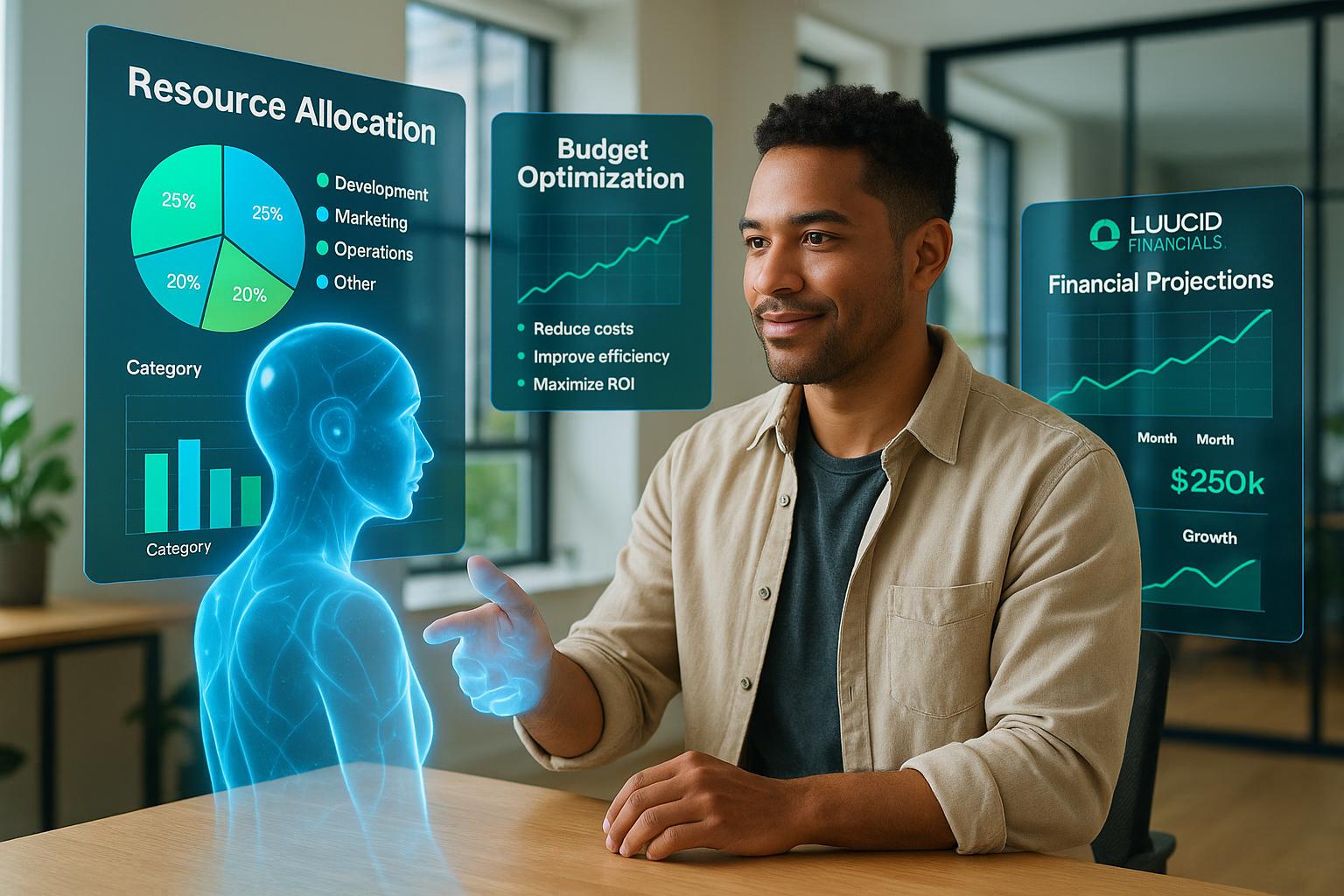Discounted Cash Flow (DCF) analysis is a widely used tool for estimating a company's value, but it often suffers from human bias, data errors, and unreliable projections. AI is changing the game by automating processes, reducing errors, and delivering more precise forecasts.
Here’s what AI brings to the table:
- Automated Data Handling: AI collects and processes financial data from multiple sources, including unstructured data like news and earnings calls, ensuring up-to-date and accurate inputs.
- Scenario Modeling: AI can simulate thousands of scenarios in seconds, identifying risks and opportunities far beyond manual methods.
- Improved Forecasting: Machine learning identifies patterns and trends, boosting forecasting precision while minimizing human error.
- Bias Reduction: AI removes subjectivity by relying on data-driven insights, leading to consistent and reliable valuations.
- Integration with Tools: AI-powered platforms like Lucid Financials connect with systems like QuickBooks, offering real-time updates and dynamic analysis.
Why It Matters: AI doesn’t replace human expertise but complements it. Analysts save time on manual tasks and focus on interpreting complex factors like market trends and management quality. This balance results in valuations that are faster, more accurate, and actionable.
AI in Valuation: How DCF Is Evolving in the AI Era
Problems with Standard DCF Valuation Methods
DCF analysis has long been a cornerstone of financial valuation, but it’s far from perfect. Beyond the usual risks of data and judgment errors, traditional DCF methods suffer from deeper flaws that can significantly distort results. Let’s break down the key issues.
Data Errors and Inconsistencies
One major problem lies in the data itself. Analysts often pull financial figures from a variety of sources - annual reports, quarterly filings, industry databases, and market data providers. Each of these sources might follow different accounting standards, reporting periods, or data collection methods, creating a patchwork of inconsistencies. These discrepancies can lead to errors in the foundational inputs that DCF relies on.
Michael Mauboussin explains this well:
"Discounted cash flow analysis is the most accurate and flexible method for valuing projects, divisions, and companies. Any analysis, however, is only as accurate as the forecasts it relies on. Errors in estimating the key ingredients of corporate value . . . can lead to mistakes in valuation."
Common mistakes include mismatching discount rates, overly optimistic assumptions, and flawed cash flow projections. Even small errors in these areas can snowball, especially in multi-year forecasts. Manual processes add another layer of risk, with potential issues like double counting or missing key items altogether.
Personal Assumptions and Bias
DCF’s reliance on projections and assumptions introduces another challenge: bias. Critical inputs like growth rates, operating margins, capital expenditures, and discount rates often reflect the analyst’s subjective interpretation. This subjectivity can lead to wildly varying results.
For instance, analysts sometimes approach valuations with preconceived notions about a company’s future. This can skew the numbers, as seen in the case of Uber. One optimistic analysis valued the company at $53.4 billion (including a large option value), while Aswath Damodaran’s more conservative approach placed it at $5.9 billion (with a smaller option value). Such disparities highlight how personal perspectives can shape outcomes. To counter this, analysts need to actively recognize and reduce their biases.
Limited Scenario Testing and Market Response
Traditional DCF methods often rely on single-point estimates for key variables, which creates a misleading sense of precision. The real world, however, is far messier. Businesses face a range of potential outcomes, and single-point estimates fail to account for this uncertainty.
Over time, even small forecasting errors can compound, making long-term projections increasingly unreliable. Sensitivity tests, while useful, often fall short because they don’t consider how market conditions can change in tandem. For example, during economic downturns, growth rates, operating margins, and discount rates may all shift together. Without robust scenario modeling, these interconnected factors can go unnoticed.
The dot-com bubble of 2000 is a cautionary tale. Many internet companies were valued on overly optimistic growth projections that ignored market volatility and competitive challenges. The result? Widespread overvaluation, followed by painful market corrections.
These shortcomings highlight the need for more dynamic and comprehensive valuation techniques, especially as financial markets grow more complex. AI-driven tools may hold the key to addressing these issues effectively.
How AI Improves DCF Valuation Accuracy
Artificial intelligence is transforming discounted cash flow (DCF) analysis by automating tedious processes, reducing errors, and providing deeper insights. These advancements lead to valuations that are not only faster but also more reliable and precise.
Automated Data Collection and Cleaning
One of the biggest challenges in traditional DCF analysis is dealing with inconsistent or outdated data. AI tackles this by automating the collection and processing of large volumes of financial information with incredible speed. Using natural language processing (NLP), AI can even analyze unstructured data from sources like news articles, earnings calls, and social media .
"AI handles the heavy lifting of analyzing market trends and extracting data-driven insights at scale, far beyond what traditional spreadsheets can do." - Angela Virtu, IAAI Associate Director and Professor of Information Technology and Analytics, Kogod School of Business
AI systems also ensure valuation models stay current by continuously updating them with real-time market data. This eliminates the delays that often make traditional DCF models outdated before they’re even completed.
Multiple Scenario Modeling and Analysis
Traditional DCF analysis often limits itself to a handful of scenarios due to the time and effort required. AI, on the other hand, can generate thousands of scenarios in seconds. This capability provides a much more detailed view of potential risks and opportunities.
For example, one company used AI to simulate various risk scenarios, including declining revenue, rising costs, and fluctuating demand. These insights allowed the company to identify its most critical vulnerabilities and fine-tune its mitigation strategies.
AI-driven scenario modeling replaces static projections with dynamic, real-time insights. This helps finance professionals shift from reactive to proactive risk management.
Better Forecasting Accuracy with AI
AI takes forecasting to the next level by identifying patterns that might go unnoticed by human analysts. It can simultaneously evaluate hundreds of variables, from broad economic trends to specific company metrics, delivering forecasts that are far more detailed and precise than traditional methods.
For instance, an industrial equipment manufacturer used AI to spot recurring delays in supplier payments. Acting on this insight, the company made adjustments that saved $500,000 annually.
"AI forecasting can lead to more objective forecasts, leaving behind the impact of regional optimism biases in forecasting. They can also incorporate resource prices and estimate their effects on supplier prices that traditional models or treasurers might miss." - Johannes Pöschl, Senior Data Scientist at Nomentia
In another case, a software company with $50 million in receivables used AI to analyze client payment patterns. By predicting which clients were likely to delay payments, the company reduced late payments by 50%, saving $390,000 annually in financing costs.
Beyond improving forecasts, AI significantly reduces human error, refining the valuation process even further.
Reducing Human Bias and Error
AI’s ability to detect overlooked patterns helps minimize subjective bias and standardizes valuation methods. This results in fewer errors and more consistent outcomes .
"AI can automatically classify transactions from bank statements, showing finance teams exactly where cash flow discrepancies are coming from - late customer payments, unexpected supplier costs, or seasonal trends. That kind of insight is invaluable." - Hubert Rappold, Senior Treasury Expert at Nomentia
Integration with Financial Platforms
Modern AI tools, like Lucid Financials, showcase how seamlessly technology can integrate with existing financial systems. By connecting with platforms like QuickBooks and payroll applications, Lucid Financials updates DCF valuations in real time. This eliminates manual errors and enables dynamic scenario planning, making the entire valuation process more efficient and accurate.
AI and Human Expertise: A Balanced Approach
AI has undeniably revolutionized DCF valuation with its ability to process data at lightning speed. However, the most reliable results stem from blending artificial intelligence with human expertise. This combination addresses issues like data inconsistencies and forecasting errors discussed earlier. When AI and human insight work together, the results are far more effective.
For instance, analysts using AI report a 35% boost in productivity and a 40% reduction in time spent on data gathering. This frees them to concentrate on interpreting complex scenarios, understanding market subtleties, and making strategic decisions.
"Despite technological advances, human judgment remains irreplaceable for certain aspects of Equity Research." - BlackRock Investment Institute
AI, as advanced as it is, cannot grasp certain qualitative factors - like management credibility or corporate culture - that account for about 30% of evaluative judgments. These elements are critical and often fall outside the scope of pure data analysis.
Take, for example, qualitative factors that influence DCF valuations but aren’t reflected in financial statements: a CEO’s proven track record during economic downturns, a company’s reputation with suppliers, or subtle changes in consumer preferences. While AI can analyze historical data related to these factors, human analysts excel at evaluating their current significance and potential impact.
By merging AI’s computational power with human insights, forecasts and price targets improve by 28% in accuracy. AI can flag anomalies - like unusual cash flow patterns - but it’s up to analysts to determine whether these signals point to temporary disruptions or strategic changes.
To thrive in this evolving landscape, professionals must sharpen skills like data interpretation, critical thinking, and effective communication. These abilities complement AI rather than compete with it. As highlighted by Harvard Business Review:
"Analysts should focus on developing skills in data interpretation, critical thinking, and communication that complement rather than compete with AI capabilities." - Harvard Business Review
Cross-checking AI-generated valuations against traditional methods and real-world data ensures both accuracy and context.
This balanced approach - leveraging AI’s precision alongside human judgment - results in DCF valuations that are not only more accurate but also more relevant and actionable. It’s this synergy that sets the stage for comparing traditional and AI-driven DCF methods.
sbb-itb-17e8ec9
Comparison: Standard vs. AI-Driven DCF Valuation
When it comes to Discounted Cash Flow (DCF) valuation, traditional methods and AI-powered approaches differ significantly in terms of speed, data processing, and precision. Traditional DCF relies heavily on manual effort, while AI-driven systems leverage real-time data and advanced algorithms to streamline the process. Here's a closer look at how these approaches stack up.
Speed
Traditional DCF models require analysts to manually gather data, build spreadsheets, and perform calculations - a process that can take days or even weeks. AI-driven systems, however, can handle 99% of the valuation workload in just minutes. They also process vast amounts of real-time data, making analyses not only faster but also more thorough.
Data Handling
Standard methods depend exclusively on structured data sources. AI tools, on the other hand, pull in both structured and unstructured data automatically. This includes information from earnings reports, social media trends, and even news sentiment, offering a more detailed view of the factors driving value.
Accuracy
Human error and subjective judgment often affect the accuracy of traditional DCF models. AI-powered systems, by contrast, use machine learning to refine their insights, potentially improving sale outcomes by up to 20%.
Risk Assessment
Traditional models typically rely on static data points that may not reflect the current market environment. AI systems continuously monitor and adjust risk profiles in real time, ensuring more dynamic and responsive assessments.
Comparison Table: Standard vs. AI-Driven DCF
| Aspect | Standard DCF Valuation | AI-Driven DCF Valuation |
|---|---|---|
| Data Collection | Manual, structured data only | Automated, integrates structured and unstructured data |
| Processing Speed | Days or weeks | Minutes to complete 99% of work |
| Accuracy | Prone to human error and bias | High precision through machine learning |
| Scenario Testing | Limited and time-consuming | Real-time testing of unlimited scenarios |
| Risk Assessment | Static and outdated data points | Continuous real-time monitoring |
| Adaptability | Limited flexibility | Learns and improves continuously |
| Comparable Analysis | Manual peer selection | Simultaneously analyzes thousands of companies |
| Bias Reduction | Influenced by analyst judgment | Data-driven approach reduces bias |
| Integration | Standalone spreadsheets | Integrated with platforms like Lucid Financials |
AI-driven tools don’t just speed up the process - they also enhance the depth and quality of analysis. For example, they can reduce due diligence time by 30%, optimize deal structuring, and evaluate hundreds of companies simultaneously. Tasks like stress-testing assumptions, modeling multiple scenarios, and identifying optimal deal parameters are completed in a fraction of the time traditional methods would require.
Traditional DCF models often reflect the inherent assumptions and biases of the analysts conducting the valuation. AI systems, by contrast, minimize subjectivity through data-driven analysis. This is particularly valuable when evaluating businesses in unfamiliar sectors or emerging markets.
Another key advantage of AI tools is scalability. While traditional methods demand more analyst time as the number of evaluations increases, AI can analyze hundreds of companies at once. By identifying relevant benchmarks from thousands of comparables, AI ensures consistent and efficient valuation across entire portfolios.
These distinctions highlight the potential of AI-driven solutions like Lucid Financials in modern financial planning. While AI provides rapid and data-rich insights, expert judgment remains essential. The best results come from combining AI's computational power with human expertise to interpret findings, account for market nuances, and make strategic decisions.
Conclusion: Using AI for Better Financial Analysis
AI is reshaping how DCF (discounted cash flow) valuation is performed by automating data collection, minimizing manual errors, and delivering dependable forecasts - even when small input changes once caused large valuation shifts. This tackles key challenges like inconsistent data, human judgment biases, and the limited scope of traditional scenario testing.
Through machine learning, patterns in extensive datasets are uncovered, enabling more accurate forecasts. These models rely on objective, algorithm-driven analysis rather than subjective human interpretation, significantly reducing bias.
In practice, integrating these advancements into financial platforms boosts decision-making. For U.S. businesses, AI-powered tools like Lucid Financials seamlessly connect with software such as QuickBooks and payroll systems, ensuring DCF models use up-to-date, U.S.-standardized data (e.g., USD, local formats). This connectivity eliminates the risks of outdated or incomplete information that often plague traditional methods.
The benefits go far beyond faster calculations. Startups can simulate growth scenarios and present compelling valuations to potential investors. Small and medium-sized businesses (SMBs) gain access to high-level analysis, allowing them to instantly compare scenarios and benchmark against industry standards. These tools enable companies to prepare more effectively for market changes and make strategic decisions with greater confidence.
Experts highlight how AI-driven methods, with their ability to process massive datasets and handle complex calculations, dramatically improve the reliability of DCF valuations. As AI technology advances, it promises even more precise forecasting, risk evaluation, and scenario modeling capabilities, further transforming financial analysis.
FAQs
How does AI improve the accuracy of DCF valuations?
AI brings a new level of precision to Discounted Cash Flow (DCF) valuations by tackling common issues like forecasting inaccuracies and inconsistent data. By leveraging real-time market insights, it can adjust critical variables - such as discount rates and risk factors - on the fly, making valuations more accurate and dependable.
On top of that, AI-driven algorithms delve into historical financial data to uncover patterns and trends. This leads to sharper revenue and cash flow projections, cutting down on human errors and reducing subjective bias. The result? DCF valuations that are grounded in data and built for reliability.
How does AI improve the accuracy of DCF valuation for small and medium-sized businesses?
How AI Improves Discounted Cash Flow (DCF) Valuation
AI is transforming how discounted cash flow (DCF) valuation is performed, tackling issues like inconsistent data and forecasting mistakes. For small and medium-sized businesses (SMBs), this translates to more dependable insights into their company's worth, enabling smarter strategic and financial planning.
With the ability to automate data analysis and use machine learning, AI delivers quicker, more accurate predictions of future cash flows. It minimizes human errors and flags potential risks, giving SMBs the confidence to plan for growth, attract investments, and stay competitive in their market.
What are the challenges of using AI in DCF valuation, and how can human expertise make a difference?
AI has the potential to refine Discounted Cash Flow (DCF) valuation by tackling common issues like inconsistent data and forecasting mistakes. Its ability to process vast amounts of information quickly makes it a valuable tool in financial analysis. That said, AI isn’t without its limits. It leans heavily on historical data, which might not account for unexpected market shifts or unique business scenarios. Plus, its accuracy depends on the assumptions it’s programmed with - flawed assumptions can lead to errors.
This is where human expertise steps in. Professionals bring contextual understanding, critical judgment, and the ability to evaluate qualitative factors that AI simply can’t process. By blending AI’s speed and analytical power with the nuanced insights of human experts, businesses can create DCF valuations that are both precise and comprehensive.


